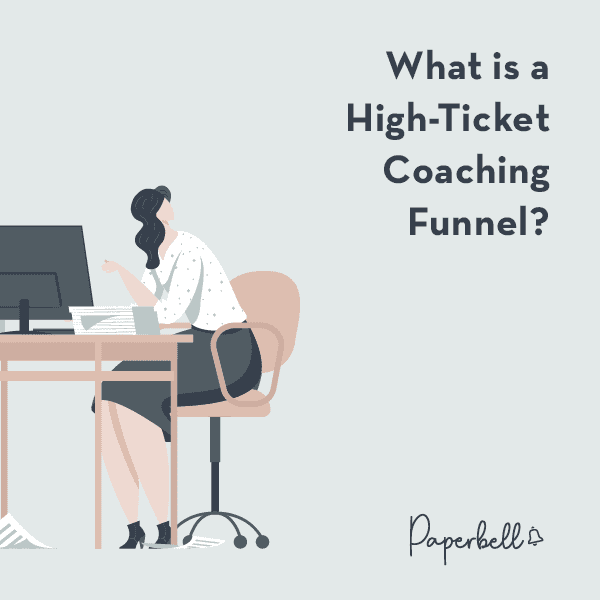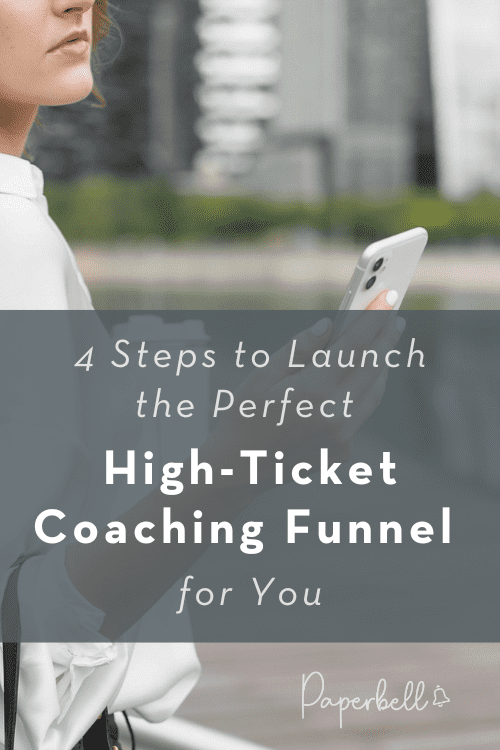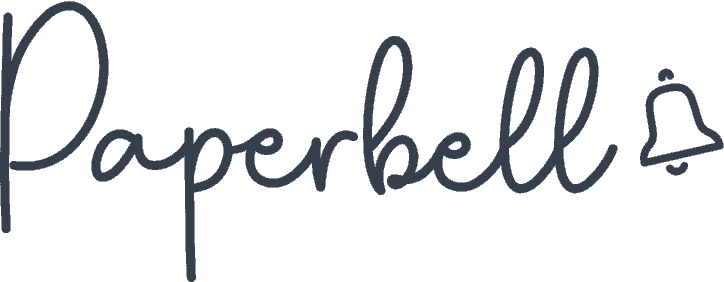So you’ve launched a high-ticket coaching program — now what?
Unless you’re an established leader in your industry, a high-ticket coaching package won’t sell itself! That’s why you need a high-ticket coaching funnel.
But what do high-ticket funnels look like in practice? And how can you create one that fits with your coaching business? Keep reading to discover:
- What is a high-ticket coaching funnel?
- The simple 4 high-ticket coaching funnel steps (regardless of your marketing strategy)
- How to create the perfect high-ticket sales funnel for your unique style
What is a High-Ticket Coaching Funnel?

A high-ticket funnel — or high-ticket coaching funnel — is a selling ecosystem that takes potential clients through the path to purchase a coaching package at a high price point.
There’s no definition of high-ticket, but it usually starts in the $2k-$3k range. Others will argue it starts at $5k.
For the majority of people, that’s a large sum of money. However, high-ticket coaching packages can be highly valuable due to the time you can invest with clients. Higher ticket means you can focus your energy on fewer people for the same revenue.
A funnel’s job is to educate and nurture potential clients to make them understand the value of your high-ticket coaching program — and to position you as an expert in your field. People enter your funnel as a stranger and come out the other end as a paying client!
The 4 Simple High-Ticket Coaching Funnel Steps (Regardless Of Your Marketing Strategy)
If you want to build your own high-ticket coaching funnel, here are the 4 vital steps you’ll need to include:
- Awareness: This is where new people find out you exist by coming across your content.
- Engagement: In this step, people who already know you further engage with your content and learn to trust you, as well as recognize you as an authority in your coaching niche.
- Conversation: You begin to engage directly with prospects. For well-established coaches who are scaling their businesses, a well-optimized sales page can take the place of a conversation.
- Conversion: Your conversation turns your prospect into a coaching client!
For example, here’s what your funnel could look like if you’re using a blog to generate traffic to your coaching website:
- Awareness: Your awesome blog content captures new readers and makes them aware of you.
- Engagement: Blog readers subscribe to your email newsletter and consistently see you pop up in their inbox as an authority figure.
- Conversation: Subscribers book a free discovery session from your email newsletters to speak directly with you.
- Conversion: On the free discovery call, you map out how your signature coaching program will work for this prospect and convince them to purchase your high-ticket offer!
Here’s another example using only social media and no email list:
- Awareness: You create engaging reels and grid posts on Instagram, which attract new followers.
- Engagement: Every day, you post Stories to keep your subscribers engaged. You ask questions via polls to engage them further.
- Conversation: Using Poll responses from your stories, you start having conversations in the DMs with your subscribers.
- Conversion: While communicating back and forth in the DMs, you map out how your signature coaching program will work for this subscriber and convince them to purchase your high-ticket offer — without jumping on a free discovery session.
And here’s a final example of an evergreen high-ticket coaching funnel that’s ideal for coaches who have dialed in their messaging:
- Awareness: You advertise a valuable lead magnet via Facebook ads. People who opt in get added to your email list.
- Engagement: An autoresponder sends out emails to your subscribers every day. Each email contains fun, engaging content and a link to your high-ticket program’s sales page.
- Conversation: Your program’s sales page walks your leads through the conversation they need to have before they’re ready to buy.
- Conversion: After reading several emails and going through your sales page several times, subscribers complete the checkout process and purchase your high-ticket coaching program.
The above are only 3 examples of what your 4-step coaching funnel can look like. But it can take virtually any shape or form!
What matters is making sure each of the 4 steps is included — and that you refine your message in a way that resonates with your ideal coaching clients.
How to Create the Perfect High-Ticket Coaching Funnel for Your Unique Style
Not every coach is in love with social media. Likewise, not every coach wants to start an email list or a blog.
Luckily, this 4-step high-ticket coaching funnel is platform agnostic! You can adapt it to your personality, style, and/or preference.
1. Collect the necessary information
You should make sure you have the right info before you start building anything in your funnel. For instance, you should have the basics, including:
- Who your offer is for
- What challenges your offer helps people with
- What outcomes your offer helps people achieve
- The logistics of your offer (price point, deliverables, timelines, etc)
- Who your dream client avatar is
But you should also ask yourself the following questions:
- If you’ve sold (or attempted to sell) this high-ticket coaching offer before, what questions, concerns, or objections come up when you speak to potential clients?
- Based on the above information, is your dream client avatar up to date? If not, what needs to change?
- If you have existing content (blogs, social media posts, email newsletters, podcasts, etc.), which pieces of content have gotten the most engagement and/or sales? On the other hand, which ones have gotten more reach/awareness?
- Does the above content cater to your dream client avatar? If not, what needs to change?
- What do your ideal prospects need to learn about you, your niche, or your offer before they’re ready to buy?
Finally, ask yourself about your personal preferences and strengths so that you can figure out the best channels for each step of the funnel. For example:
- What method do you find easiest to communicate with? Writing, speaking, via video, using visual graphics, etc.?
- What online platforms do you already tend to use (and enjoy) in your time?
- On a scale from 1 to 10, how tech-savvy are you?
Each time you must choose a medium for a step in your funnel, remind yourself of your answers. For example, launching a podcast won’t make sense if you struggle to articulate yourself verbally. Likewise, it won’t make sense to put all your eggs in the email basket if you express yourself best via video!
2. Develop your awareness content
Awareness content is designed to reach new people who haven’t heard about you yet. You obtain this reach by paying for it (via ads) or leveraging algorithms (such as SEO) to appear organically in front of new people.
At this early stage, your content shouldn’t be designed to pitch your high-ticket coaching packages. Instead, it should be designed to get the attention of people who are dealing with the type of problems you help solve.
If you’re unsure what topics to cover, consider doing keyword research around your niche!
Here are just some examples of awareness content you can develop:
- Blogging and Pinterest
- Awareness content on social media (such as Reels or TikTok videos)
- Youtube videos
- Podcasting
- Appearing as a guest on other people’s podcasts/blogs/summits
- Ads
3. Create your engagement content
Engagement content is designed for people who are aware of who you are and what you do. At this stage of the funnel, they’re considering whether or not you’re the person they want to trust to help them overcome their challenges.
Bring back the answers from step 1 for the question:
What do your ideal prospects need to learn about you, your niche, or your offer before they’re ready to buy?
Your engagement content should start to educate your audience about these things. This content should also start to address common questions, concerns, or objections.
Engagement content is also a great place to share your own success stories as well as client case studies. For example, take a look at this client success story from career coach Em Pescott in her email:

Some examples of engagement content include:
- Email newsletters or autoresponders
- Social media Stories or feed content
- Free training videos
- Private podcasts
- Facebook groups
- Youtube videos (designed for your existing audience)
- Blog posts (designed for your existing audience)
- Retargeting ads
4. Facilitate conversations
Conversations are a necessary part of any coaching funnel, but it’s even more important when you’re selling in the high-ticket space.
Unless you already have a proven funnel in place that you now need to scale, you shouldn’t remove real conversations from your funnel. Many coaches want to automate their sales process by using a long-form sales page, but they do so way too quickly!
You can still use a sales page to sell your high-ticket offer, even if you don’t have a proven process yet. But instead of trying to sell your offer, make the goal of your sales page to convince readers to book a call with you instead.
The more free discovery calls you have, the more you’ll learn about your dream clients. You’ll get to know how they think, what their struggles are, what they desire, and so much more!
And you can use what you learn to refine your programs — but ultimately, you’ll be able to create better content and copy.
You can have these conversations in other formats as well, including:
- Email chains (especially when you ask your email subscribers to hit reply)
- Social media DMs
- Website chat
- Texting
- Voxer
5. Determine your conversion channels
This step is the natural continuation of the previous step — conversations. But keep in mind that conversions can happen in a different context than conversations.
For example, you could start a conversation with an email subscriber via email replies. But if you find it helpful to get on a discovery session to qualify clients properly, don’t try to force the conversion via email directly.
Some examples of conversion channels include:
- The checkout page of a sales page
- Selling directly on a phone call/discovery call
- Selling via a proposal or checkout page sent after the phone call
- A simple checkout link sent via DMS or email
Launch Your High-Ticket Coaching Funnel Today
Now you know what it takes to create a high-ticket coaching funnel. Remember that even though one coach claims their funnel works best won’t mean it’s the best method for you. That’s why you should approach your funnel in the way that works best with your strengths as a coach.
If you’re overwhelmed with all the tech needed to create a high-ticket coaching funnel, we get it! And that’s exactly why we created Paperbell — to make it simple for coaches of all experience levels to sell their coaching online.
Claim your free Paperbell account today to start building your high-ticket coaching funnel without all the tech overwhelm!










